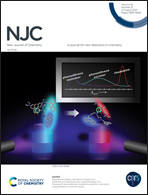Surface defect engineering and morphology control of graphitic carbon nitride with synergistically improved photocatalytic performance†
Abstract
A simultaneous exploration of surface defect engineering and morphology control is critical for applications in designing high-performance solar energy utilization systems. In this study, a new strategy based on the nitrogen defect and ultrathin nanosheets of graphitic carbon nitride (CNDNS) is introduced via in situ vapor treatment. This strategy not only contributes to the material with increased specific surface area and ultrathin nanosheets morphology that offer numerous active, reactive sites and promote photogenerated charge transfer, but also brings rich nitrogen defects with a regulated band structure. The synergistic effect endows CNDNS with a superior photocatalytic performance for removing dye pollutants. The possible photocatalytic degradation mechanism is proposed, and the results ascertained that superoxide free radicals and holes play a major role in the entire photocatalytic degradation reaction. This study provides a new idea for the construction of high-performance, low-cost, and durable g-C3N4 catalysts with broad applications.



 Please wait while we load your content...
Please wait while we load your content...